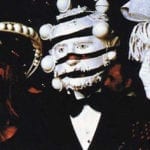 Politics
Politics  Politics
Politics  Weird Stuff
Weird Stuff Ten Bizarre Facts About The Doge Meme
 Our World
Our World 10 Ways Your Christmas Tree Is More Lit Than You Think
 Movies and TV
Movies and TV The 10 Coolest Stars to Set Sail on The Love Boat
 History
History 10 Things You Didn’t Know About the American National Anthem
 Technology
Technology Top 10 Everyday Tech Buzzwords That Hide a Darker Past
 Humans
Humans 10 Everyday Human Behaviors That Are Actually Survival Instincts
 Animals
Animals 10 Animals That Humiliated and Harmed Historical Leaders
 History
History 10 Most Influential Protests in Modern History
 Creepy
Creepy 10 More Representations of Death from Myth, Legend, and Folktale
 Politics
Politics 10 Political Scandals That Sent Crowds Into the Streets
 Weird Stuff
Weird Stuff Ten Bizarre Facts About The Doge Meme
 Our World
Our World 10 Ways Your Christmas Tree Is More Lit Than You Think
Who's Behind Listverse?

Jamie Frater
Head Editor
Jamie founded Listverse due to an insatiable desire to share fascinating, obscure, and bizarre facts. He has been a guest speaker on numerous national radio and television stations and is a five time published author.
More About Us Movies and TV
Movies and TV The 10 Coolest Stars to Set Sail on The Love Boat
 History
History 10 Things You Didn’t Know About the American National Anthem
 Technology
Technology Top 10 Everyday Tech Buzzwords That Hide a Darker Past
 Humans
Humans 10 Everyday Human Behaviors That Are Actually Survival Instincts
 Animals
Animals 10 Animals That Humiliated and Harmed Historical Leaders
 History
History 10 Most Influential Protests in Modern History
 Creepy
Creepy 10 More Representations of Death from Myth, Legend, and Folktale
10 Times Stamps Caused Unexpected Controversies
Stamps may not be at the forefront of our minds in today’s digital age. But they remain an important part of postal history and culture—and daily usage. One aspect of stamps that often goes unnoticed is the process of selecting the images that adorn them. In the United States, this task falls to the Citizens Stamp Advisory Committee. That’s a group that meets regularly to deliberate on thousands of stamp ideas submitted by the public.
While aesthetic appeal is certainly a factor in their decision-making, there are also guidelines for what can be depicted on a stamp. But even with these regulations in place, controversies still arise. Both the United States and other countries have faced backlash for stamp designs that have offended certain groups. Some have even caused international incidents!
In this list, you’ll learn about ten examples of controversial and ill-advised stamp design choices. These stamps serve as a reminder of the importance of careful consideration in creating them. Who knew this much hubbub could be caused by such a small adhesive postal tool!
Related: Top 10 Shockingly Controversial Billboards
10 Civil War Generals (United States)
The Civil War was, of course, a defining moment in American history. It officially came to an end in 1865, but the memories of its battles have raged on ever since. In the 1930s, tensions surrounding the conflict flared up once again. That time, it came in the form of multiple heated debates among stamp collectors.
In 1937 and 1938, the U.S. Postal Service released a series of ten stamps meant to honor some of the country’s most famous military heroes. Among these stamps was one depicting William Tecumseh Sherman, a Union general known for his brutal tactics during the Civil War. Sherman was famous for his “march to the sea,” which resulted in widespread destruction in the South during the fight. Sherman had been honored on stamps before, but for whatever reason, it hadn’t been a big deal. By the 1930s, though, it was different.
His stamp appearance brought significant opposition from southern residents. Many Southerners were still bitter about the devastation wrought by Sherman during the war, having parents and grandparents who lived through it. So they threatened to boycott the stamp. In fact, the legislatures of Georgia and South Carolina even passed official resolutions against it. Despite this, the stamp was a success. In fact, some Southerners even bought it just so they could finally “lick” Sherman.
Fearing more controversy, the government released a stamp featuring Confederate general Robert E. Lee. It was meant to appease angry Southern stamp collectors. However, it failed in its own right because the stamp depicted Lee, a three-star general, with only two stars on his collar. Southern military buffs interpreted the mistake as a deliberate insult to their hero, and a second Civil War stamp controversy bubbled up.[1]
9 Bernard Revel (United States)
The process of designing postage stamps is a rigorous one. Usually, multiple committees are tasked with reviewing and approving every aspect of the design before it is released to the public. However, there is one individual who has the power to alter the approved design (mostly) without detection: the person responsible for etching the final design before production.
In 1986, this is exactly what happened in a very unfortunate moment. That year, the U.S. Postal Service released a stamp honoring Yeshiva University’s centenary. The stamp featured the image of noted Jewish rabbi and scholar Bernard Revel. Kenneth Kipperman was the man behind the design.
At the time, he was one of very few people allowed to engrave stamps. A year before the stamp’s release, he had subtly added a Star of David to Revel’s beard. It sat in near invisibility in the very corner of Revel’s mouth where his mustache meets his beard. The alteration went unnoticed until 1987 when a stamp-collecting outfit tipped off The Washington Post.
Immediately, the post office went into damage control. The U.S. Postal Service made it clear that while it is not uncommon for engravers to personalize their work, it is not allowed. Still, the insertion of religious commentary into a federally created stamp worried the organization. They tried their best to walk back the controversy even though it took months for the thing to even come out.[2]
8 Stalin’s Supporters (Russia)
The passage of time has a way of obscuring history. For those who lived under a brutal dictator, for example, the memories of their atrocities are awful and unending. But for future generations, the actions of such rulers may be viewed in a more relaxed way. This is certainly the case in Russia—especially when it comes to Joseph Stalin.
In the 2000s, only a third of Russians considered Stalin’s actions to have been bad. Despite the forced executions of countless people during his reign, modern Russians don’t seem to see the harm. So it makes morbid sense why in 2001, the Russian government released a set of stamps honoring Stalin’s henchmen. Despite being very bad men during their lives, decades had passed, and Russia simply thought it was time to give them glory again.
Those pictured on the postage were some of the most awful mass murderers ever. Sergei Puzitsky, for example, oversaw the killings of half a million Cossacks in Russia. And he got himself a post-millennium stamp! Russia’s chief stamp designer even defended the decision to honor these men. “We’re starting to realize in Russia that not everything in our history was bad,” said Boris Mitukin, the Russian House of Stamps’ chief designer, in a BBC interview that year. “These were honest, decent citizens. Some of them were even geniuses. They helped protect our country and our people.”
Many others refused to see it that way, though. “It’s a slap in the face to the millions who died in that totalitarian system,” said one Russian woman who spent five years in a gulag. “It’s just awful that we live in a society where hangmen and murderers are glorified.”[3]
7 Burhan Wani (Pakistan)
The relationship between India and Pakistan has been fraught with tension and hostility for many years. Despite occasional attempts to improve relations, the two countries have remained at odds with each other. That doesn’t mean politicians haven’t tried to cool tensions, though. One very notable attempt occurred in 2018.
That year, Imran Khan became the prime minister of Pakistan. Immediately, he signaled his willingness to work toward resolving differences with India. However, a planned meeting between the foreign ministers of the two countries was abruptly canceled by India. A number of things went into the misfire, but chief among them was a Pakistani stamp commemorating martyrs who died fighting for the country in the Kashmir region.
Not long before Khan took power in Pakistan, the country had issued several stamps in honor of “Kashmir Martyr’s Day.” The stamps were meant to commemorate the deaths of Pakistani fighters, including a notable man named Burhan Wani. But the stamps quickly became divisive. India also claims Kashmir for itself—hence the tension with Pakistan—and Indian officials viewed those being honored on the stamps as terrorists.
This caused a rift in the relationship between the two countries. Very quickly, the hope for détente crumbled. India labeled Wani and the other Pakistani fighters terrorists and condemned the stamp. Pakistan rejected the label and moved forward with using it in postal work. Through it all, the two countries’ relationship remains strained.[4]
6 The Brontosaurus (United States)
Did you grow up with a favorite dinosaur when you were little? Was it the brontosaurus, by chance? If it was, you should know the brontosaurus doesn’t actually exist. See, paleontologists have actually “discovered” that gigantic, long-necked dinosaur twice. The first time they found it, they called it an apatosaurus. The second time around, new scientists “discovered” it again and termed the beast a brontosaurus. The second name stuck in pop culture, though.
But experts were concerned about the overlap, and once they figured out each set of fossils came from the same dinosaur, they made the move to work it back to the original name. So brontosaurus was yanked while apatosaurus was pushed, and all was good, right? Wrong! Most of us regular folks did not get the memo about the name change. Pretty much everybody went on calling it a brontosaurus, even as “experts” tried in vain to stop it.
The post office did, too! In 1989, the U.S. Postal Service came out with its own brontosaurus stamp. Even though that name had long since been retired at the time, the postage people didn’t care much about what the fossil folks had to say. Paleontologists tried to get the stamp changed, but the Postal Service (correctly) realized the country knew that dinosaur by its, um, incorrect name. So they went forth with a brontosaurus stamp!
Still, scientists seethed at the decision to transmit incorrect information. The Smithsonian Museum’s head of paleontology sputtered that the post office’s choice to use “brontosaurus” despite being told otherwise “suggests that the Postal Service cares little for the accuracy of the stamps they issue and they prefer ‘cartoon’ nomenclature to scientific nomenclature.” Feisty![5]
5 The Crimean Bridge (Ukraine)
The violent conflict between Russia and Ukraine has been marked by moments of fierce resistance and bold defiance. Despite initial predictions that Kyiv would fall quickly to the Russians in early 2022, Ukrainian soldiers have shown remarkable determination. One notable example occurred when a small group of soldiers stationed on an island refused to surrender to a Russian warship.
Instead, they told the ship’s crew to “go f*** yourself.” While the men were eventually taken captive, the incident was celebrated as a symbol of Ukrainian resilience. Soon, it was even commemorated with a stamp in the country. But that wasn’t the war’s controversial stamp. Not by a long shot!
No, that one came after the destruction of the Crimean Bridge. The billion-dollar bridge was built by Russia after it first annexed the Crimean Peninsula back in 2014. Ever since, the span has been seen as an unwelcome symbol of Russia’s permanent presence in the area. In October 2022, on Vladimir Putin’s birthday, an explosion destroyed the bridge. Ukraine didn’t admit to being behind the blast, but the symbolism was very clear. And the host government moved to take advantage of it!
Hours after the explosion, Ukraine released a stamp that showed two people standing defiantly on the edge of the broken bridge. For a country that claimed not to be involved in the explosion, the stamp’s quick release was a head scratcher. Still, it was a very bold statement—and one that perfectly encapsulated the tensions of war.[6]
4 Richard Nixon (United States)
When it comes to evaluating the performance of past presidents, opinions vary greatly. But one president is widely considered to have had the most tumultuous tenure in office: Richard Nixon. Of course, he is the only president in American history to have resigned from office, which followed his administration’s role in the Watergate scandal.
That controversy led to widespread public disapproval and calls for his impeachment. So when he left office, it’s an understatement to say he was polarizing at best—and downright unpopular at worst. Nevertheless, presidents have a long history of being honored with postage stamps after they die. And when Nixon passed in 1994, that tradition continued, even as objections rose.
Despite the controversy surrounding Nixon’s presidency, the U.S. Postal Service decided to honor him by releasing a stamp in the mid-1990s featuring his image. This decision was met with criticism from across the country. Many regular citizens and politicians alike expressed their opposition. The head of the House Post Office and Civil Service Committee, for instance, wrote a letter to the Postal Service expressing his disbelief at the decision.
Nixon didn’t deserve a stamp, the argument went, because he had lied to the American people and Congress. Despite the backlash, the Postal Service proceeded with the release of the stamp. But thankfully, Americans got creative in their protest. Some people even went so far as to creatively alter envelopes around the stamp to make it appear as though postage-stamp Nixon was behind bars.[7]
3 Marie Stopes (United Kingdom)

In 2008, the United Kingdom’s Royal Mail issued a set of stamps to honor six women who had made significant contributions to the country. They felt it was long overdue to honor those women, considering most stamps previously had been for men. One of the women chosen was Marie Stopes. She was a pioneering English figure in the field of family planning. She wrote the first widely-available book on the topic way back in 1918. Three years later, in 1921, she opened the first free clinic offering abortion and family planning services.
However, Stopes was also a vocal advocate for eugenics, and she believed in the concept of a master race. This fact caused a great deal of controversy and backlash at the time the stamp was announced. The furor came both from those who were against her views on reproductive rights, as well as those who identified as feminists.
In 2008, the charity founded by Stopes dismissed the negative response to the stamp. They noted that despite the controversy about some of her beliefs, Stopes’s achievements were undeniable. But by 2020, the organization had changed its stance. They recognized that the darker aspects of her legacy could not be ignored. The charity even moved to change its name to MSI Reproductive Choices.
By doing so, they finally admitted that the positive aspects of her legacy could not be separated from the truly reprehensible ones. This change came after a decade and a half of increased awareness and discussions about race and implicit bias. As for the stamp, it made it through the 2008 run, even amid controversy. Knowing the 2020 charity change, though, means it’s unlikely Stopes will ever be honored again by the Royal Mail.[8]
2 Where’s the Cigarette? (United States)
Smoking was far more prevalent—and accepted—among past generations in America than it is today. It wasn’t unusual to see notable, world-famous celebs taking a drag off a cigarette. Now, that doesn’t happen quite as often. But a few decades ago, it was the norm. However, things have changed pretty rapidly in the last thirty or so years. And the U.S. Postal Service got caught in a major controversy twice right in the middle of that shift.
It all began in 1994 when blues guitarist Robert Johnson was honored with his own stamp. But the picture his postal pose was based on had been altered: The iconic cigarette he’d been holding was gone! Quickly, people became upset with the post office for taking out the cigarette and altering the image. Critics said it changed the entire context of Johnson’s pose. For their part, the Postal Service said the cigarette was wiped because “they didn’t want the stamps to be perceived as promoting cigarettes.”
Amazingly, five years later, the whole thing happened again. In 1999, the USPS released a stamp honoring iconic artist Jackson Pollack. However, the stamp was missing one key thing: the painter’s ever-present cigarette! During his life, Pollack was known for smoking while painting. Images of him hard at work virtually never capture the brilliant man without a cigarette in his mouth. It was simply part of who he was.
So when the stamp came out with no cigarette, Pollack fans and art historians alike balked at the choice. The artist who created the stamp even threw the Postal Service under the bus for it! “It was an instruction to me,” the illustrator later told the Baltimore Sun, “to remove the cigarette.” That choice didn’t sit well with art aficionados. They claimed the cigarette-free stamp put Pollack’s portrayal completely out of context.[9]
1 Beating Alcoholism (United States)
Governments that create stamps (probably) aren’t sending subliminal messages through the post. And companies who purchase those stamps usually aren’t trying to send a secret message to their employees or letter recipients, either. They’re just trying to ship out postage in bulk to do business. And whatever the stamp says is secondary to getting the letter delivered on time. Right? Well, in some cases, notable stamp choices have led to bizarre and unfortunate conspiracies.
Take the case of the alcoholism stamp of 1981, for example. That year, the U.S. Postal Service released a stamp that read: “Alcoholism: You can beat it!” The intention behind the stamp was admirable. At the time, alcoholism was not a topic that was very openly discussed. So it was good to talk about it and hopefully get people on a healthier track!
The stamp’s release was part of a much larger program too. It was accompanied by a national advertising campaign designed to start a conversation about the issue. However, the post office didn’t anticipate the confusion caused by the stamp. By the time they had printed almost 100 million of them, it was too late. And the reason for its unpopularity was an incredible one.
By 1985, the Postal Service admitted they’d messed up after the stamp completely failed to sell. That year, they explained why when asked about it by the Los Angeles Times. “Apparently, people felt putting that stamp on a letter was suggesting to the person receiving it that he has a drinking problem,” employee James Van Loozen recalled. “You have to be careful what you put on stamps.” No kidding! And now the Postal Service knows better… we hope![10]








